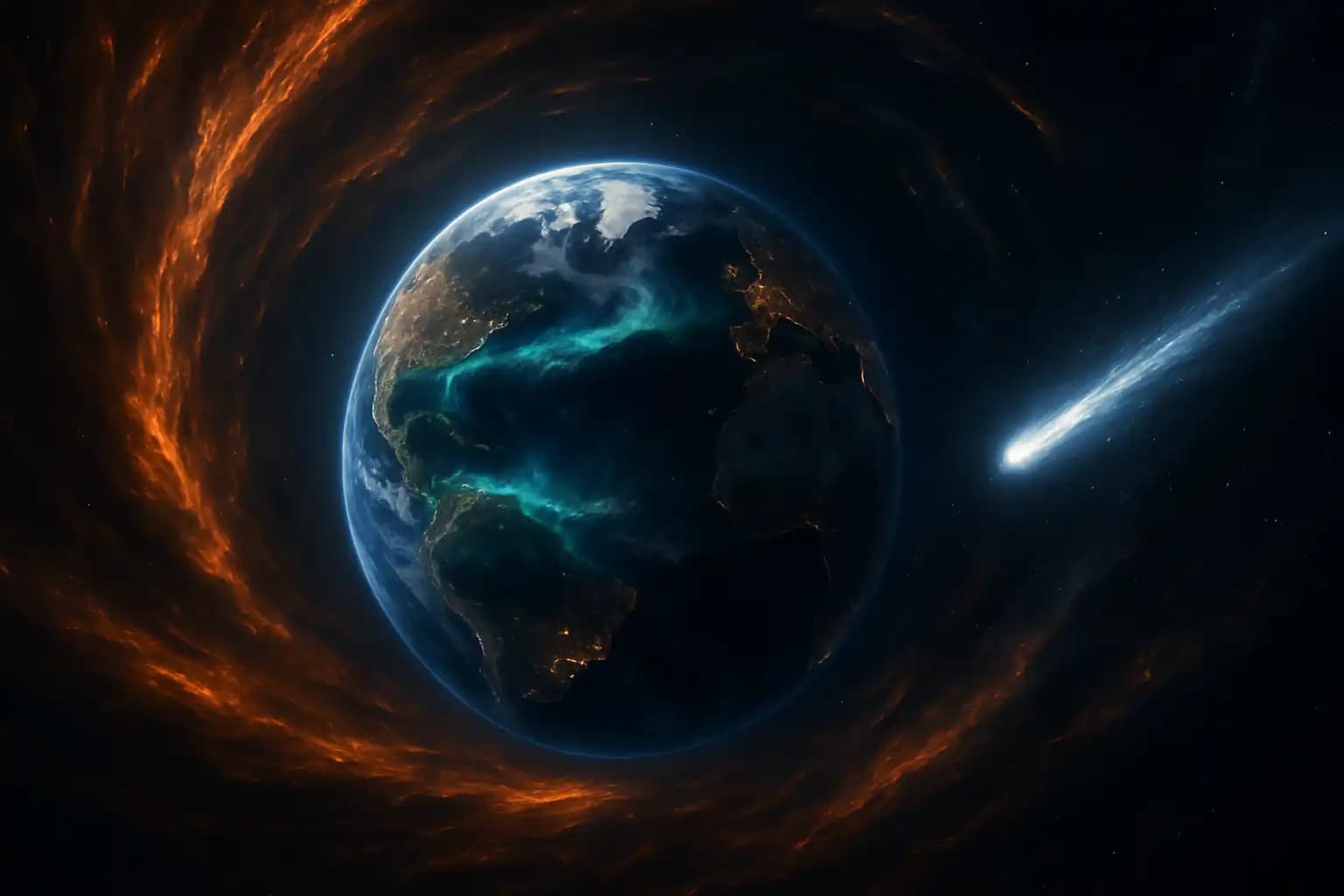Every generation sees itself at the center of history—and 2025 is no exception. Sensational headlines warn of a “solar superstorm apocalypse.” Viral videos track the path of interstellar comet 3I/ATLAS. Cosmic catastrophe talk surrounds us. But what’s real science, what’s overhyped, and why does Earth’s spotlight feel hotter than ever?
Solar Superstorm 2025: Real Risk or Overblown Fear?
Solar activity is increasing, with experts warning of a peak solar cycle in 2025 that could dwarf past events. Studies from WIRED Middle East indicate this surge may cause a geomagnetic storm akin to the Carrington Event of 1859. That event set telegraph wires ablaze and triggered global auroras. The potential fallout? Satellite disruptions, long-lasting power grid failures, and trillions in economic damage. NASA has intensified early warning efforts, but global infrastructure faces greater exposure than ever. As outlined in The Planetary Society’s 2024 brief, even a moderate storm could disconnect millions from power. However, not all space theorists predict doom—some highlight improving predictive models. Planned missions like SWFO-L1 and IMAP (launching in 2025) offer the best monitoring yet.
Solar storms are more than Hollywood tales; their effects are real. For a technical overview, see the scientific background on solar storms. The crucial question: Will our society invest in resilience, or wait for cosmic roulette?
3I/ATLAS: The Interstellar Comet Captivating Researchers (and Conspiracy Theorists)
The discovery of interstellar comet 3I/ATLAS—as a true outsider—has sparked academic fascination and prophetic hysteria. As covered by the Times of India, the comet zipped through our neighborhood in late October, dazzling us with its unusual composition and tail formation. Despite wild claims of “alien origin” or disaster, the facts remain: 3I/ATLAS never approached within 167 million miles of Earth, posing zero threat to humanity. Instead, its passage has provided astronomers a rare sample of interstellar material—helping decode the chemical origins of planetary systems, as evidenced by NASA’s ongoing efforts in their official 3I/ATLAS portal.
This rare visitor’s data surge mirrors excitement (and speculation) from sources such as deep-dive comet reporting and apocalyptic AI scenario coverage—reinforcing our cultural appetite for cosmic mystery and existential fear-mongering.
Milankovitch Cycles and the Reality Behind Global Cycle Theories
Recent media noise about “global cycles” casting Earth as the cosmic focal point echoes centuries-old speculation. Scientifically, these cycles are known as Milankovitch cycles, oscillations in Earth’s tilt, orbit, and wobble—spanning tens to hundreds of thousands of years. NASA’s 2024 climate research (full article) dismisses the idea that current changes are cosmic in origin. Current warming closely correlates to greenhouse gas emissions, with no evidence of extraordinary Earth alignments. Yet these theories resurface during planetary crises, akin to debunks of missing time and occult legend explorations exploiting collective angst. Yet, there’s beauty in the cyclic rhythms that have shaped ice ages, sea levels, and planetary habitability long before and after our Twitter feeds.
What It Means: Is Earth the Center of the Action, or Just in the Crosshairs?
Is something big about to happen, with Earth as the headline act? The short answer: Earth is always ‘the center’ from our perspective. However, the 2025 convergence is more about uncertainty and connectivity than any cosmic targeting. Solar superstorm risk is real but manageable with preparation—as demonstrated in infrastructure reviews like this critical assessment. The comet 3I/ATLAS event is remarkable but not threatening; global climate cycles continue as usual. Our fears reflect the interconnectedness and vulnerability of a civilization reliant on technology. As indicated by historical economic collapse parallels and modern security field reports, understanding true existential risk involves separating the spectacular from the speculative.
Why does it all matter? Building resilience—against space weather, financial shocks, or cultural panics—requires nuance and vigilance, not memes about cosmic destiny. For context, evolving scientific breakdowns, and (occasionally wild) speculation, turn to Unexplained.co, your source for the truly big stories.





